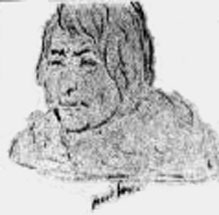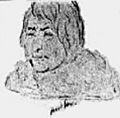Crazy Bear (Assiniboine chief) facts for kids
Crazy Bear (born 1785, died 1856) was an important leader of the Assiniboine tribes. These tribes lived in the northern plains, in areas that are now Montana, North Dakota, Alberta, and Saskatchewan. He was known for being a very good negotiator with the American Fur Company at Fort Union in North Dakota.
Crazy Bear was also a key person at the Fort Laramie Treaty Council in 1851, where he signed an important treaty. He earned the name Mah-To-Wit-Ko, which means "Crazy Bear," because he fought like a wild bear. The word "Wit-Ko" can mean crazy, foolish, frightening, or mad. He was also known by the French name Ours Fou.
Crazy Bear had three granddaughters: Iron Cradle (also called Sweet Grass), Turtle Door, and Small Earth. He also had two grandsons: Black Bull and Kill Eagle. Iron Cradle later became a well-known person at the early Fort Belknap Indian Reservation in Montana.

Contents
Crazy Bear's Early Life
Crazy Bear was born in 1785 on the northern plains. This area is now part of Montana, North Dakota, Alberta, or Saskatchewan. The world around him was changing very quickly. In 1803, the United States bought the huge Louisiana Territory from France.
Long before Crazy Bear was born, the Assiniboine people had separated from the Yankton Sioux. This led to many years of fighting between them.
Growing Up as a Warrior
Crazy Bear grew up living the traditional life of the Plains Indians. He learned to follow and hunt buffalo. He was also taught the ways of a warrior. He lived a brave life and was known for his many acts of courage. It was clear to his people that he was a natural leader.
Life was tough for young men learning to hunt and fight. Many did not survive to adulthood. European diseases also made it harder for young Native Americans to live. But Crazy Bear overcame these challenges and became an adult.
In 1805, the famous Lewis and Clark Expedition met some Assiniboine people. Crazy Bear was about 20 years old at this time. It's possible he met these famous explorers himself.
The Fur Trade and Crazy Bear's Wisdom
We don't know much about Crazy Bear's early adult life. However, there is a story about a battle between the Assiniboine and the Gros Ventre tribes. In this fight, Crazy Bear bravely protected the women and children of his camp. People said his actions were like "the furious and fearless actions of a crazy bear," which is how he got his name.
Trading at Fort Union
Crazy Bear and his tribe took part in the growing fur trade. This trade brought French traders, known as Coureurs des Bois, to the plains. Later, others like voyageurs and mountain men joined in. Companies like the Hudson's Bay Company and the American Fur Company (AFC) built trading posts along the rivers. Native Americans traded furs and buffalo robes for things like weapons, fabric, and other goods.
Crazy Bear became very skilled at negotiating at one of these posts, Fort Union in Dakota Territory. He was known as an honest and reliable trading partner. The agents of the American Fur Company often wrote in their journals about Crazy Bear's abilities.
In 1842, an AFC agent named Charles Larpenteur wrote about another fur company trying to get Crazy Bear to switch sides. This company offered Crazy Bear a fancy military suit and a keg of whiskey. But Crazy Bear showed his loyalty to Fort Union. He went to the AFC agent, Mr. Culbertson, and took off all the fancy new clothes. He threw them on the floor, saying, "I am not a child who can be tricked with trinkets." He explained that he would not leave the "big house" (Fort Union) where his ancestors had traded for so long. This showed that Crazy Bear was not "crazy" at all, but a very wise and strong leader.
The Fort Laramie Treaty of 1851
By 1851, many white settlers were traveling west through the northern plains. This led to more conflicts with Native American tribes. Also, the ongoing wars between different tribes affected the fur trade. The United States government wanted to stop these fights.
A Call for Peace
The U.S. government created a document called the "Fort Laramie Treaty" (1851). They invited leaders from many tribes to a meeting at Fort Laramie in Wyoming. Tribes like the Sioux, Cheyenne, Arapaho, Crow, Assiniboine, and others were invited. Many of these tribes were enemies and had been fighting for centuries.
Fort Laramie was in Sioux territory, so many leaders were worried about traveling there. The journey was also dangerous because of other enemy tribes. But Crazy Bear decided to go. He convinced several others to join him, including Chief First to Fly.
When the leaders arrived, there were about twelve thousand people, far more than expected! The U.S. officials were scared. They moved the treaty signing to a safer location, about 35 miles away.
Signing the Treaty
The U.S. government wanted specific "Chiefs" to sign and represent their tribes. Crazy Bear was chosen to represent the Assiniboine.
The treaty had several important points:
- It called for an end to all fighting between tribes and with white settlers.
- It set specific territories for each Native American nation.
- The U.S. government promised to pay yearly payments (annuities) for fifty years.
- The U.S. government also promised to protect tribes from white settlers.
- In return, the Native American nations agreed to allow white settlers to travel safely through their lands. They also agreed to let the U.S. Army build forts.
Crazy Bear and other Chiefs signed the treaty and mostly kept their promises. However, the U.S. government did not. They changed the annuity payments from fifty years to ten years. They also failed to stop white settlers, miners, and hunters from entering Native American lands.
After signing the treaty, Crazy Bear and Chief First to Fly received silver medals. They then returned to Fort Union. Sadly, Crazy Bear found that his son, Holy Seat, had been killed by the Blackfeet tribe. His child and wife had also died. Even though he was very sad, he bravely told his people about the treaty.
Because the U.S. government was late with the first yearly payments, Crazy Bear's people made fun of him. But he remained calm and strong. When the goods finally arrived, his people were amazed and praised him.
Later Life and Death
After the treaty, Crazy Bear continued to lead his tribe and tried to keep peace with the U.S. government. Because of his family's tragedy, he took on the responsibility of raising his granddaughter, Sweet Grass (Iron Cradle).
Despite the treaty, life was still hard for the Plains Indians. More white settlers arrived, diseases spread, and the buffalo, their main food source, were decreasing. In 1854, Crazy Bear wrote a letter expressing his worries: "I see the buffaloes decrease every year. What will become of us without help?"
Crazy Bear's Passing
Crazy Bear caught the terrible disease smallpox and died in 1856 at the age of seventy. The smallpox epidemic was devastating for the northern plains tribes. It killed about 2,000 people, with an estimated 1,200 being Assiniboine. Crazy Bear is buried near where the Big Muddy River flows into the Missouri River.
Crazy Bear was known as a good and sensible leader. He cared deeply about his people's interests. Even when he was young, his opinions were respected in council. He was a strong friend to white men and worked hard to create understanding between his people and the U.S. government. He was truly a great leader.
Images for kids


